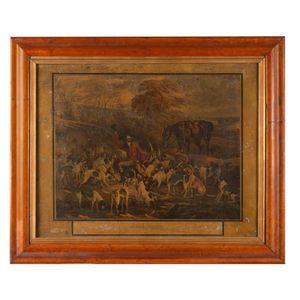Portrait of T. Goosey by John Ferneley
John Ferneley (1782-1860), portrait of T. Goosey, chromolithograph with varnished textured finish, original maple frame with gilt slip and glazing, 53 x 67, frame 69 x 84 cm overall
You must be a subscriber, and be logged in to view price and dealer details.
Subscribe Now to view actual auction price for this item
When you subscribe, you have the option of setting the currency in which to display prices to $Au, $US, $NZ or Stg.
This item has been sold, and the description, image and price are for reference purposes only.
- Chromolithograph - A chromolithograph is a type of print that uses multiple layers of color to create a detailed and vibrant image. The process was invented in the mid-19th century and quickly became popular for reproducing a wide variety of images, including advertisements, illustrations, maps, and art prints.
Chromolithography is a complex process that involves creating a separate stone or metal plate for each color in the image. The artist or printmaker first draws the image on a stone or metal plate using a greasy substance, such as a crayon or a wax-based ink. This image is then transferred to a separate plate for each color in the image. The plate is then coated with a thin layer of a light-sensitive substance, and then exposed to a light source. The light hardens the parts of the plate that are not covered by the image, creating a raised surface that will hold the ink.
Once the plates are ready, they are inked up with the corresponding color and printed one at a time, with each color being printed on top of the last. The process is repeated for each color, with the final image being made up of many layers of color.
It was widely used in the late 19th century and early 20th century for posters, postcards, advertising and illustrations in books and magazines. However, chromolithography has been largely replaced by modern printing techniques such as offset printing and digital printing, which are faster, cheaper, and more efficient. Today, chromolithography is mainly used for fine art prints and reproductions, as well as for creating limited-edition prints of historical or cultural significance - Maple - Maple, native to North America, is a dense heavy timber from light to yellow-brown in colour. It has very little distincive graining unless it is one of the variants such as birds-eye maple or burr maple, so was not used extensively for furniture in 18th and 19th century, where cabinetmakers and designers preferred timbers with more distinctive features such as mahogany, walnut, rosewood and oak.
Birds-eye maple has a seres of small spots linked by undulating lines in the grain, is highly sough and is used as a decorative veneer. Burr maple has larger and irregular grain swirls than birds-eye maple.
This item has been included into following indexes:
